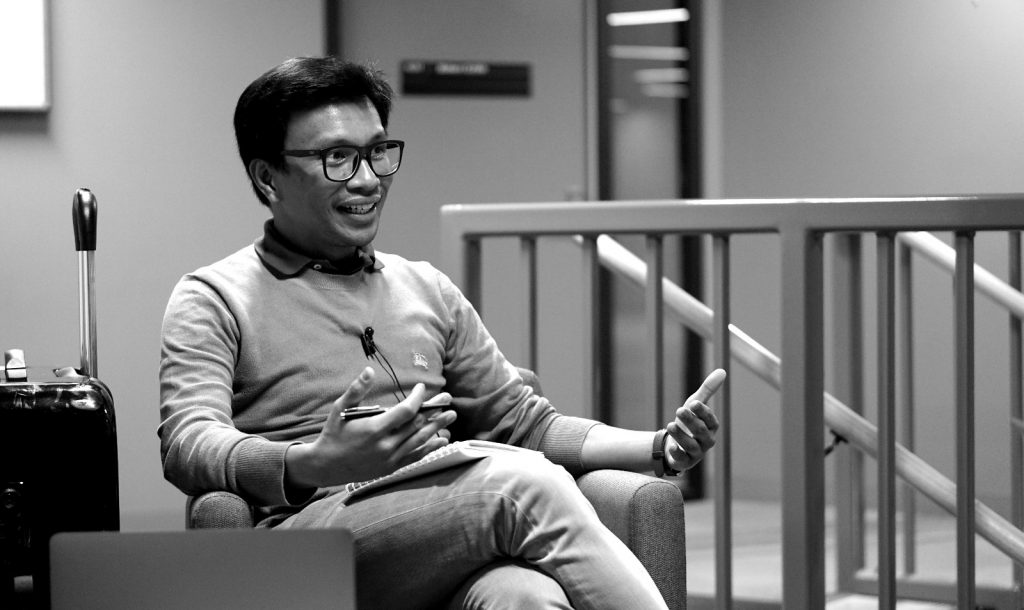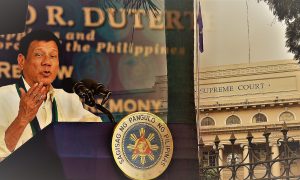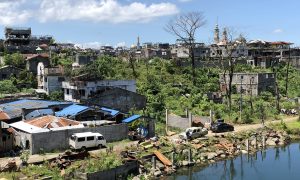Catholic. Run by dynasties. Crime-ridden. Enamoured of America. Obsessed with beauty. These are a few of the stereotypes that colour international perceptions of Southeast Asia’s fastest growing economy—and that New Mandala readers will hear dismantled in a series of podcasts on the theme of “The Philippines Beyond the Clichés” hosted by our Philippines editor Dr Nicole Curato.
In the first of five interviews with researchers, Nicole gets Associate Professor Jayeel S. Cornelio (Twitter: @jayeel_cornelio) to unpack the statement that “The Philippines is a Catholic country.” A sociologist by training, Jayeel is one of the leading scholars of contemporary religious life in the Philippines, and heads the Development Program at Ateneo de Manila University. His latest book is Being Catholic in the Philippines: Young People Interpreting Religion (Routledge 2016).
You can listen to the audio below at our Soundcloud page, at iTunes, or via the Apple Podcasts app. A transcript of the Q&A between Nicole and Jayeel, with links to the books and articles referenced in their conversation, is available below.
• • • • • • • • • • • •
Nicole Curato (NC): Jayeel, a warm welcome to you. It’s your first time in Canberra.
Jayeel Cornelio (JC): It is my first time in Australia! Thank you so much for having me here, Nicole.
NC: Alright, let’s start with the big picture. The Philippines is a Catholic country, we are often told. What does this mean? Is this even true? And is that question even useful? Tell us the lay of the land.
JC: Excellent. There are two ways to answer that question. One is statistically, the other one is in terms of its politics and diversity in other forms.
So statistically speaking, we know that the Philippines remains to be predominantly Catholic, only because 80% of the population profess that religion and about 5-10% Islam, 5-10% Evangelical Christianity, and then the remaining fraction would be for other new religious movements.
But to frame religious diversity according to statistics like this betrays the situation on the ground. What do I mean by that? Religious diversity is also manifest in terms of how other religious groups, and we have to realise that there are many religious groups and denominations and traditions and even new religious movements that are asserting their presence in the public sphere in different ways. Politically for example, they have fielded their own candidates if not supporting certain candidates. Or they’re also asserting their presence in terms of say, building their own architectural feats around the country. So, there are many ways of discerning, so to speak, the visibility and presence of religious diversity in the country today.
NC: Yeah, I remember you were making this argument in your book in 2016 when you were arguing that when we think about religion in the Philippines, don’t think of it as a monolithic entity because it’s so comfortable for outside observers like myself to say it’s a Catholic nation therefore it’s conservative. Therefore, the future of the Philippines or Catholicism in the Philippines is secure. Therefore, divorce will never be legalised in this super-Catholic country. So, talk us through this impression I guess that because it’s a Catholic country, the Philippines is a conservative country.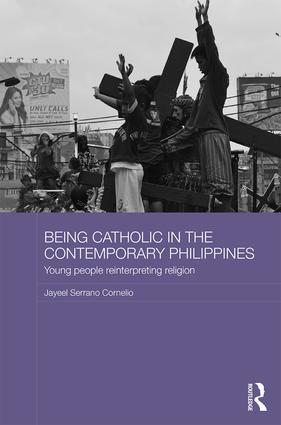
JC: This is in fact a mistake precisely because when we look at Catholicism in itself as a religion in the country, you have to diversify your understanding. On one hand, you’ve got institutional Catholicism. And by that we mean the leadership, with its official statements and in many cases, we know that the institution, the leadership frames the Philippines as a Catholic country religiously speaking. So much so that we almost neglect the presence of Islam and Evangelical groups and other Christian groups in the country because of that powerful discourse.
But having said that, we also want to consider how Christianity or Catholicism plays on the ground. Many Filipinos may not necessarily echo the perspectives or sentiments of the Catholic institution say in relation to the Reproductive Health Law or in relation to divorce. We know that Philippine society is neatly divided based on—
NC: We’re at what? 50-50 split, right?
JC: It’s 50-50, really. Really. I mean it used to be—the majority used to be against divorce not too long ago, about 5 or 6 years ago. And now we know that Philippine population is already half-half with regards to divorce. And then we know also on the Reproductive Health Bill, 70% of Filipino Catholic adults supported the Reproductive Health Bill, what was then the Reproductive Health Bill [sic]. So very important to factor in how religiosities play on the ground in relation to people’s perceptions of issues that matter to them.
NC: And of course, you talked about this extensively in your book where you focused on the Filipino youth and the different practices of their religiosity on how—I may have gotten this argument wrong—on how they express some level of individuality within an institution. So, walk us through your empirical findings of that work.
JC: No, I’m quite impressed that you picked it up that way.
NC: Of course! I’m a serious Philippine studies scholar! (laughs)
JC: (laughs) And this is exactly the point of that book. I’m showing there that instead of secularising which is the typical argument that you find about religious change among young people in the West and many other parts of the world, for example the rise of religious nuns, right? In the US, North America or in Western Europe. What we see in the Philippines is that you’ve got young people who are still very assertive about their Catholic identity. But not in ways that many leaders or many traditional religious individuals might expect.
So, for example, I’ve argued there that by simple asking them, “What does it mean to be Catholic to you?” Young people are saying that, “Oh, I don’t necessarily have to go to Catholic church to exercise my Catholicism. Or to go to mass on a regular basis. I may volunteer for a relief operation somewhere or support a disaster recovery somewhere and so forth.” The idea being that for many young people—and this is the catch phrase that I have in the book—right living is more important than right believing. Right living is more important than right believing. What does it mean? It’s a very moral kind of understanding of what it means to be Catholic today. More than it is say for previous generations for whom piety, going to mass or praying the rosary was far more important and the practice of it defined their Catholicism. Not so in the case of our young people today.
NC: And is that finding widely shared by a lot of Philippine studies scholars doing work on Philippines and religion? Because you also edited the special issue of Philippine Studies Journal with our colleague, Manuel Sapitula from the University of the Philippines. So, talk us through the latest developments.
JC: That’s right. The Philippine Sociological Review, you mean? Or Philippine Studies?
NC: Philippine Studies as well.
JC: Oh yeah. I edited that and then Manuel Sapitula contributed to it. You’re right. So it’s a collection, yeah. So this came out in 2014 and—
NC: In time for Pope Francis’s visit in the Philippines.
JC: That’s right.
NC: Who enjoys what? 80% trust rating among Filipino adults, right?
JC: That’s right. And I think the Filipinos are the most appreciative of this Pope. And maybe that makes us a papist society.
NC: (laughs) Okay, can I quote you on that? (laughs)
JC: Maybe. Just maybe. (laughs) So the point is that—so that was a fantastic collection and to those who are listening to this podcast, you may simply just google this: Philippine Studies, Filipino Catholicism. And easily you find many of the articles downloadable for free.
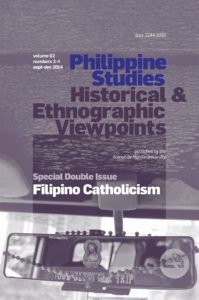 The point that we tried to do in that collection is to document how Catholicism is changing and is also critically assessed by different kinds of scholars, historians, even theologians themselves, anthropologists and sociologists. The argument that I am making in the introduction and also in my own piece there is that there appears to be a turn to everyday authenticity, that’s a catchphrase that I used there. The turn to everyday authenticity. What does it mean? When we look at the writings about Christianity in the Philippines, it appears that many scholars are now recognising that in contrast to the arguments made by older scholars that Christianity is split level—
The point that we tried to do in that collection is to document how Catholicism is changing and is also critically assessed by different kinds of scholars, historians, even theologians themselves, anthropologists and sociologists. The argument that I am making in the introduction and also in my own piece there is that there appears to be a turn to everyday authenticity, that’s a catchphrase that I used there. The turn to everyday authenticity. What does it mean? When we look at the writings about Christianity in the Philippines, it appears that many scholars are now recognising that in contrast to the arguments made by older scholars that Christianity is split level—
NC: Yes.
JC: Meaning like Father Bulatao who we know that that is his big argument, that say Catholics are split level. They go to church and yet they do something else. You know, practice corruption and so on and so forth. That same understanding, that same theoretical framework has also been used to analyze say popular religiosity. How come people still go to mass and yet they still use amulets for example? So thereby creating what we know as folk Catholicism. But from the point of view of everyday authenticity, we reject these kinds of hierarchies of religiosity simply because for many ordinary Catholics, all of these are expressions of their Catholicism. Peter Bräunlein, a German anthropologist calls this 100% Catholic so people who flagellate themselves or people who crucify themselves during Holy Week say in Pampanga or in Bulacan, they might be accused of not being faithful to the Catholic doctrine or to the Catholic practice because you don’t really need to crucify yourself but for these people, this actually expresses their Catholicism.
NC: Yeah, I actually like that kind of discussion when we talk about religiosity in the Philippines because when we think about practices in the Philippines, it’s always assessed based on a you know Enlightenment, European standard. Either we’re not secularising correctly or we’re not being Catholic correctly.
JC: Exactly. Either way—
NC: And I think that’s kind of—it’s really annoying and it’s really not meaningful. Instead of thinking about these things ethnographically from the ground and try to theorise the kind of practices that we have as a nation.
JC: Absolutely. Those perspective are in fact Orientalist. We’re always inadequate. Either not Catholic enough or either not secular enough.
NC: So, self-flagellation during Holy Week you think is an expression of everyday authenticity?
JC: Expression, because when you—yeah, anthropologists have interviewed these people and they would say that, “Oh, this is very much in line with our Catholic identity. We’re doing this because we are Catholic, not in spite of.”
NC: Right. And it’s not a less form of articulating religiosity. That’s the argument of a lot of contemporary—
JC: Contemporary social scientists. So, the job of any observer therefore, whether you’re a journalist or a commentator about religion in the Philippines today, is to simply take a step back and understand why are people doing this?
Devotees of the Black Nazarene is another—or you know, they provide another way of understanding Catholicism in the Philippines. Why do they have to go through all the mess in early January to follow hundreds of thousands of other devotees in order to suffer and sacrifice themselves? But precisely because this is the whole point of being Catholic in the Philippines today. It is true to who they are as Catholics.
NC: Alright. Well, Jayeel, make my day and let’s shift gears to politics. (laughs)
JC: (laughs) Politics, okay.
NC: Of course, I would like to ask you about the influence of religious movements in the Philippines and my reading of your work and the work of other Philippine studies scholars on politics is that there are of course, many ways to think about the church or religious movements in politics.
We can first talk about for example, how the Catholic Church does not shy away from stepping into politics and in critical historical junctures, even being the loudest voice in ousting presidents. So, for our listeners who are still getting acquainted with Philippine politics, there is a popular narrative that the Catholic church has been instrumental in two People Power Revolutions, one that ousted the dictator Ferdinand Marcos in 1986 where Cardinal Sin, the Archbishop of Manila appealed to the people in the airwaves of Radio Veritas to march to EDSA—and he also appealed to the military not to hurt or to inflict violence against its own people. And again in 2001 when Jayeel and I were undergraduate students (laughs)—
JC: That’s right, yes. Back in the day.
NC: Right. The Catholic Church was at the forefront in a political campaign to oust President Joseph Estrada because of corruption allegations and other immoral deeds like womanising, alcoholism, gambling. So, I think what I want to ask you is where are we now? Where is the Catholic Church in Rodrigo Duterte’s Philippines?
JC: Excellent question. We have reason to believe, Nicole, that the public presence of the Catholic Church with regard to political issues like this may have started to wane already. Surveys show that more and more Filipinos do not like it when priests use the pulpit to talk about politics.
NC: Oh, okay. Right.
JC: In fact, we know as I’ve mentioned a while ago that about 70% of Filipino Catholic adults supported the Reproductive Health Bill. Even if many Catholic priests and even institutional leaders themselves have voices their resistance to what was then called the Reproductive Health Bill. That resistance has become more—and maybe what I can say is that the Reproductive Health—the drama over the Reproductive Health Bill surfaced the sentiments of many Catholic Filipinos that the church should be less and less involved in politics. So, this is no longer 1986 and 2001.
What does this mean for the Catholic Church? I understand from a theological perspective that the Catholic Church sees itself as a prophet. It has a prophetic role in the public sphere to resist what it sees as moral decline or political mistakes. Anything that could affect the public and this harks back to the understanding that the Philippines is a Catholic country and therefore, its morality must be upheld. Sometimes it backfires, sometimes it works. But generally speaking, this is a difficult game now for the Catholic Church. What parallels that development interestingly in my view is now the increasing assertiveness of other religious groups. You’ve got Iglesia ni Cristo, even Jesus is Lord, even Apollo Quiboloy’s Kingdom of Jesus Christ in Davao. And we can name many other religious groups that are making their presence felt in the political and public spheres in Philippine society today. Some of them have fielded their own candidates, some of them have expressed their resistance to certain policies or support for certain other policies. Is this unique today? Not necessarily. We know that even in the 1970s and 1980s, the Evangelicals have been very vocal about certain political issues. But what makes it more perhaps fascinating in the 21st century is that you have a bigger and more diverse group of Christian groups, Christian denominations and religious movements at play now.
NC: So, there is a fragmentation of influence when it comes to religious movements in the Philippines? That the Roman Catholic Church, you think, fearless forecast does not have the same power that it did in 2001 and in 1986 when it asked the people to go to the streets and oust the president. They cannot do that in Duterte’s Philippines?
JC: Oh, they can do that but they need to do that in a very wise manner because as I have argued in one of my opinion pieces for Rappler a year ago, the Catholic Church should be very wise in terms of presenting itself as a civil society actor. By simply voicing its resistance to Duterte, it does not necessarily help clarify the issues for the public and it simply adds to the noise if you will, the cacophony in the public sphere.
But you were talking about fragmentation, right? So, you’re saying—so you might get the impression that religious participation, religious political participation is getting more and more fragmented in the Philippines right now. Yes, but—and here’s my argument. Even if there are so many other religious groups now that are at work in the political and public spheres, in fact I would argue that there is a common denominator across all of them. They’re all militant. They’re all—in many ways conservative also. Right? They want to support religious leaders that would maintain stability in society. They would—they have—they would support in many ways even right-wing politics in the country. Of course, this demands a lot more research on our part but the point is that you’ve got a lot of Christian groups that are either fielding their own candidates or supporting candidates. And this is what makes their position in the civil society pretty tricky. Are you really religious or are you political?
NC: Right. Which I guess brings me to the I guess second ways in which religious movements can influence Philippine politics. There is an impression that they can actually swing elections. And I think we have to unpack this. In 2019 there will be a mid-term election. And we will see senators, congressmen, trying to win favors from let’s say Pastor Quiboloy, the supposedly—what does he call himself? The appointed son of God, right?
JC: Well, that’s what he calls himself.
NC: They try to get endorsement from a lot of these charismatic religious leaders. Is that a real influence? Can we really say that they shape elections?
JC: Can they really shape elections? That’s a very good question. There are… the typical impression is that they can sway elections in favor of one candidate over the other. But I think this matters more at the level of the communities or local governments more than it does say at the level of national elections. Iglesia ni Cristo has conservative estimates about 2 million or 2.25 million voters—members, not everybody votes but we also know that it depends again on the surveys. About 80% or so of them adhere to the endorsed candidates of their leadership.
NC: Right. And for our listeners, Iglesia ni Cristo is one of the fastest growing indigenous churches in the world.
JC: In the world, yes. So, it’s an indigenous church in the Philippines. Iglesia ni Cristo in English is Church of Christ and it celebrated its 100th anniversary in 2014 and it believes to be the one true—the true form of Christianity in this day and age, which in effect the end times already. And this is a very important theological assertion on the part of Iglesia ni Cristo that sets them apart from other religious groups. But they’re no longer just a religious group. They’re very much politically involved because—
NC: They are known for bloc voting.
JC: For bloc voting. Of course, when you talk to the church officials, they would not say that they vote as a bloc or they endorse certain candidates, yeah. But these are theological nuances. From an outsider’s point of view, they vote as a bloc. But it is a theological matter as far as they are concerned because to them, Iglesia ni Cristo has a theology of unity that the endorsement of the leadership needs to be respected by practically everyone in the church regardless of whether they subscribe to these political candidates or they support these political candidates or not because the unity of the church is at stake. But there is a survey recently, I can’t remember the specific statistical data now, that shows that in fact not quite a lot of people have followed the line of the leadership. But we have to check that because this always tricky you know when you conduct surveys like this you know after the elections, some people may not necessarily say whatever in fact they did, you know during the elections but yeah, so to what extent they sway elections in favor of national candidates remains to be a tricky question to answer. The same thing for Apollo Quiboloy, the same thing for the Evangelicals. We know that—again, to just reinforce my point—we know that many Evangelicals supported Brother Eddie Villanueva when he ran not once but twice for president—
NC: For presidency, yes.
JC: Yup. And once for senator but not once did he win in any of these elections. The idea was that there was a Born Again Christian bloc. But apparently there’s none. Precisely because—and this is where sociology of religion really matters—on the ground, you see that the institution is very very much fragmented.
NC: Right. And I think the third one is kind of curious to me. And now we’re going through your entire body of work. (laughs) Because I read your piece at the journal Religion, State and Society where you actually argue that Iglesia ni Cristo has expanded its power not just to the voting bloc but really to the concept of civic engagement. And my reading of this work is the church now acts as this institution for redistribution of wealth and welfare among the people. Is that a fair interpretation? That you have this religious organisation serving the function of the state?
JC: Exactly. So, an alternative state if you will.
NC: Right. An alternative state.
JC: Alternative state. And this has become increasingly the big role of Iglesia ni Cristo in particular and some other churches I have to admit say in the wake of Typhoon Haiyan. But this is not just unique to Iglesia ni Cristo. Civic engagements are already the mark of other religious movements in the country.
We know that Tzu Chi for example, a Buddhist—Taiwanese Buddhist religious movement has played and continues to play big roles in disaster recovery in the Philippines and because we are a country of disasters literally and figuratively (laughs) you expect that Tzu Chi would always be there. And Evangelical churches are also playing their part. What does this mean? I have to explain that yes, you’re right, this is increasingly the interest of my scholarship now because I see that—as I said as we were—at the onset of this podcast that religious diversity in the Philippines needs to be understood not just in terms of statistics but in terms of how these other religious minorities are asserting themselves.
A while ago, we talked about their political game if you will. But now I am also seeing that religious groups are making their presence felt through civic engagements. This is called religious philanthropy in the literature. When you talk about Buddhism, these Buddhist engagements, Catholic Church—of course, the Catholic Church has a very long history of charitable works and acts around the world. But I am less interested in the Catholic Church that I am say in other religious groups because we are seeing that they are making their presence more visible in this manner.
So, to go back to your point, is this a demonstration of themselves as an alternative state? Yes, that’s one. But the other point that I want to make also is that these churches, we have to realise, are making their presence felt not just locally but internationally. This is where my whole point about religious worlding comes in. Iglesia ni Cristo may be the fastest growing indigenous church, Filipino indigenous church in the world today. But it’s not just a religion in the Philippines, it’s a religion in the world. You go to Africa, they’re there. You go to North America, they’re there. You go to Western Europe, they’re there, buying properties even from old religions and converting them into their own worship halls. It’s the same thing for Jesus is Lord, Evangelical churches, congregations in North America, Hong Kong, Singapore, and where else? The same thing for Every Nation which is the head movement of Victory Church. And so on and so forth. We can go on and on and I see that these churches are making their presence felt around the world. Their headquarters are in the Philippines, they’re born in the Philippines but they’re out there in the world.
NC: So, what does that say about the nation?
JC: Exactly. So, the narrative of religion in the Philippines is no longer about suffering. It is about triumph.
NC: I think I want to shift gears a bit because we are talking about religion in the Philippines taking a claim globally. But of course, we also have to look at the region and when we see Malaysian politics, Indonesian politics, we are also talking about political Islam. What sorts of comparison can we—if any, can we draw from the Philippines?
JC: Right. Comparisons need to be both direct and indirect. Indirectly, we have to see that—we have to recognise that Islam is a minority religion in the Philippines. But we also know that if we look at Catholicism in the Philippines as a majority religion, it has been playing a big role—or it has played a big role in politics and we know that Islam continues to do that say in Indonesia or in Malaysia and I have to admit that this is quite the character of majority religions wherever you might be in Southeast Asia.
NC: I see. So it’s not an Islam issue. It’s an issue of dominant religion.
JC: Buddhism. We know Buddhism in Thailand, Buddhism in Myanmar, and even Buddhism which people wrongly assume to be the only religion of peace in the world has its own violent, extremist tendencies. We see this certainly in mainland Southeast Asia. We see this certainly in the case of Islam in Malaysia and in Indonesia, and certainly in Christianity in the Philippines. Why is this the case? Because these religious groups, because they are the majority, they see the nation not only as a political space but also a religious space. So the imaginary is not only secular. The national imaginary is also religious. Even if the constitution might deliberately say that these are non-religious or secular societies.
NC: Yeah, for better or worse, right?
JC: For better or worse, of course. Of course.
NC: So I think one of the last questions I want to ask you is kind of like a free for all question. So aside from the themes that we’ve already tackled, we talked about the church and politics, we talked about the changing articulations and performances of religiosity in the Philippines. Are there are other emerging trends or patterns that you spot with practices of religion in the country?
JC: This is an exciting question through which I could promote my forthcoming article. (laughs)
NC: (laughs) No shock there. (laughs)
JC: No, I try to be humble. (laughs)
NC: As a religious tenet. (laughs)
JC: (laughs) So I am contributing to the Edinburgh Companions to Global Christianity and they’re releasing a volume on East and Southeast Asia very soon and in my chapter there, I describe Christianity in the Philippines in two ways: it’s militant and it’s global. Militant and global. These in my view are the trends of religious change in the Philippines. I’m a sociologist of religion and primarily my interest is in how religion is changing. And I’m no longer just interested in Catholicism. I’m interested in Iglesia ni Cristo, that is quite obvious now. I’m interested in Jesus is Lord, Evangelical churches and even Apollo Quiboloy down south. The point is that these churches are very militant one, in terms of their political presence.
Duterte Harry: Fire and Fury in the Philippines
New Mandala's Philippines editor talks to Jonathan Miller about his new biography of the president.
NC: And their own cable channel.
JC: Their own cable channels broadcast around the world. They’re present also certainly on social media. This is not unique to Iglesia ni Cristo, you find it among Victory Christians, they’ve got their own training center in Bonifacio Global City with the clear mandate of missionising the rest of Asia and other parts of the world. And this narrative may have begun in the 1980s, post 1986 where—during which the hope of many Filipinos of the country was also paralleled with the emergence of new religious movements at that time. Evangelical Christian churches, many of them were born in the 1980s. And now we’re seeing they’re flourishing about 20 or so years later on. Very global.
NC: Right. That’s incredibly fascinating. So, I guess in conclusion and to summarise everything that we’ve discussed, is the Philippines a Catholic country? Does that question make sense?
JC: It doesn’t make sense anymore. While for other people it might still make sense because of the predominance of Catholicism among the population, in reality and on the ground, this is no longer the case. My research and many of social scientists right now, our studies are an invitation to the public to start seeing and recognising religious diversity in the Philippines today. This matters. Why? Because if we are not sensitive to the diversity in our country, sooner or later we may have conflicts that we don’t want to have in the first place.
NC: Alright! There you have it. Thank you, Jayeel! Jayeel Cornelio is the author of the book Being Catholic in the Philippines: Young People Interpreting Religion published by Routledge in 2016. Thank you for joining us.
JC: Thank you so much, Nicole for having me.
 Facebook
Facebook  Twitter
Twitter  Soundcloud
Soundcloud  Youtube
Youtube  Rss
Rss 